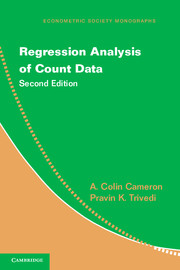Book contents
- Frontmatter
- Dedication
- Contents
- List of Figures
- List of Tables
- Preface
- Preface to the First Edition
- 1 Introduction
- 2 Model Specification and Estimation
- 3 Basic Count Regression
- 4 Generalized Count Regression
- 5 Model Evaluation and Testing
- 6 Empirical Illustrations
- 7 Time Series Data
- 8 Multivariate Data
- 9 Longitudinal Data
- 10 Endogenous Regressors and Selection
- 11 Flexible Methods for Counts
- 12 Bayesian Methods for Counts
- 13 Measurement Errors
- A Notation and Acronyms
- B Functions, Distributions, and Moments
- C Software
- References
- Author Index
- Subject Index
- Miscellaneous Endmatter
2 - Model Specification and Estimation
Published online by Cambridge University Press: 05 July 2014
- Frontmatter
- Dedication
- Contents
- List of Figures
- List of Tables
- Preface
- Preface to the First Edition
- 1 Introduction
- 2 Model Specification and Estimation
- 3 Basic Count Regression
- 4 Generalized Count Regression
- 5 Model Evaluation and Testing
- 6 Empirical Illustrations
- 7 Time Series Data
- 8 Multivariate Data
- 9 Longitudinal Data
- 10 Endogenous Regressors and Selection
- 11 Flexible Methods for Counts
- 12 Bayesian Methods for Counts
- 13 Measurement Errors
- A Notation and Acronyms
- B Functions, Distributions, and Moments
- C Software
- References
- Author Index
- Subject Index
- Miscellaneous Endmatter
Summary
INTRODUCTION
This chapter presents the general modeling approaches most often used in count data analysis – likelihood-based, generalized linear models, and moment-based. Statistical inference for these nonlinear regression models is based on asymptotic theory, which is also summarized.
The models and results vary according to the strength of the distributional assumptions made. Likelihood-based models and the associated maximum likelihood estimator require complete specification of the distribution. Statistical inference is usually performed under the assumption that the distribution is correctly specified.
A less parametric analysis assumes that some aspects of the distribution of the dependent variable are correctly specified, whereas others are not specified or, if they are specified, are potentially misspecified. For count data models, considerable emphasis has been placed on analysis based on the assumption of correct specification of the conditional mean or of correct specification of both the conditional mean and the conditional variance. This is a nonlinear generalization of the linear regression model, in which consistency requires correct specification of the mean and efficient estimation requires correct specification of the mean and variance. It is a special case of the class of generalized linear models that is widely used in the statistics literature. Estimators for generalized linear models coincide with maximum likelihood estimators if the specified density is in the linear exponential family. But even then the analytical distribution of the same estimator can differ across the two approaches if different second moment assumptions are made.
- Type
- Chapter
- Information
- Regression Analysis of Count Data , pp. 21 - 68Publisher: Cambridge University PressPrint publication year: 2013
- 1
- Cited by

